Harissa is a North African red chile paste or sauce made of a few simple ingredients including chiles, garlic, olive oil, citrus and a few warm spices.
This versatile harissa recipe is slightly sweet, smoky, tangy, and just enough spicy but not too hot. Make it ahead and use in many ways! Be sure to watch the video below.
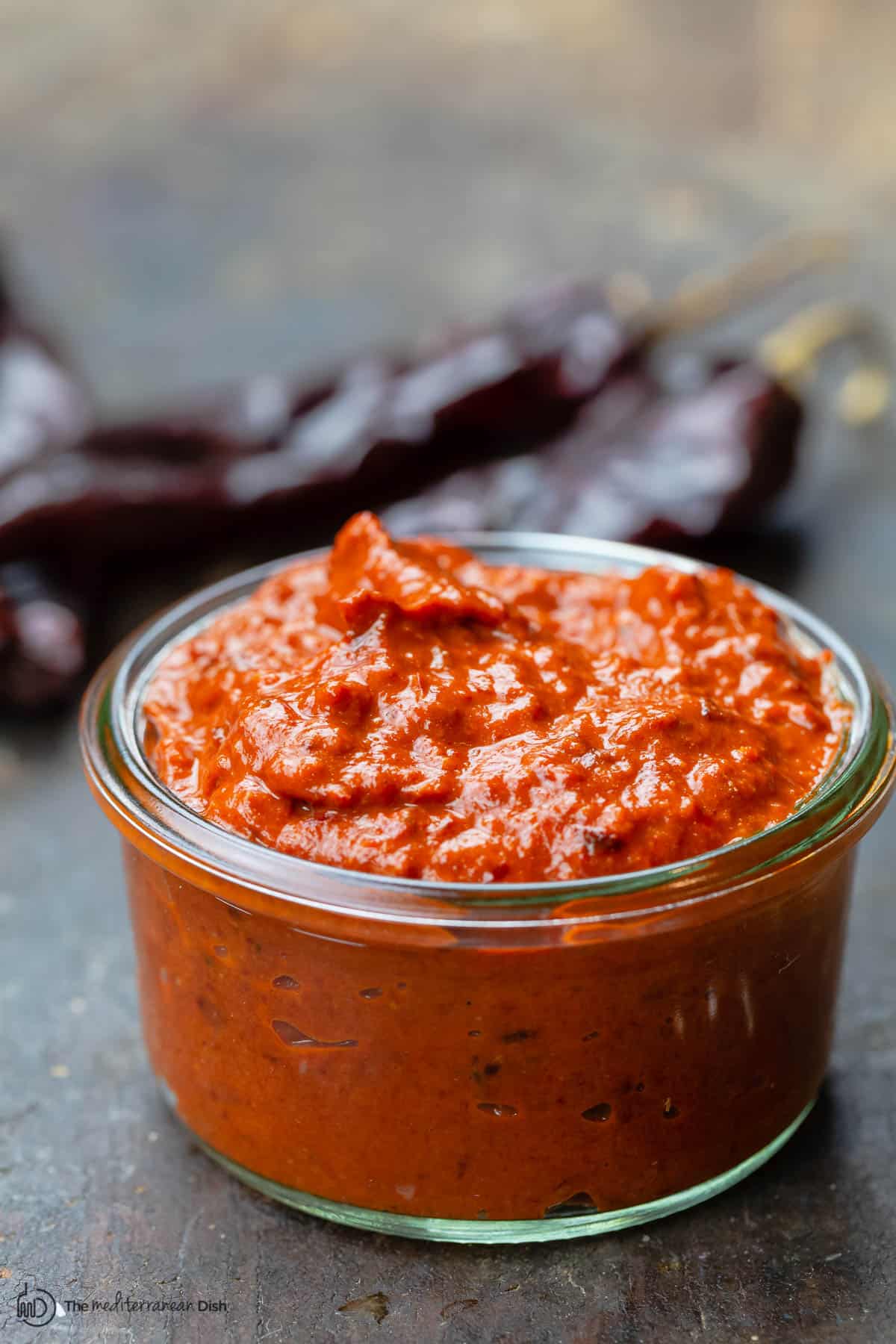
You’ve seen me use harissa spice blend in different recipes, but today we’re going to chat about harissa sauce! This, along with my earlier toum garlic sauce, belong under versatile Mediterranean dips and condiments you’ll find yourself using over and over again!
What is harissa?
I’ve heard people describe harissa as the ketchup or sriracha of North Africa and the Middle East.
It may be a red condiment that is as popular as ketchup because of the many way it is used and enjoyed. But comparing the two does not do harissa justice. Harissa is much more complex in flavor and all together addictive!
Originally from Tunisia, harissa is a chile sauce or paste typically made of dry red chiles, garlic, citrus, extra virgin olive oil and a few warm spices including cumin, coriander and caraway seeds.
And although you can find it at specialty grocery stores sold in jars or tins, homemade harissa is a completely different experience.
What does it taste like? This harissa sauce recipe is mild with just enough kick, sweet, smoky, and a little bit tangy. Absolutely addictive!
Making harissa at home is easier than most people think; be sure to watch the video below.
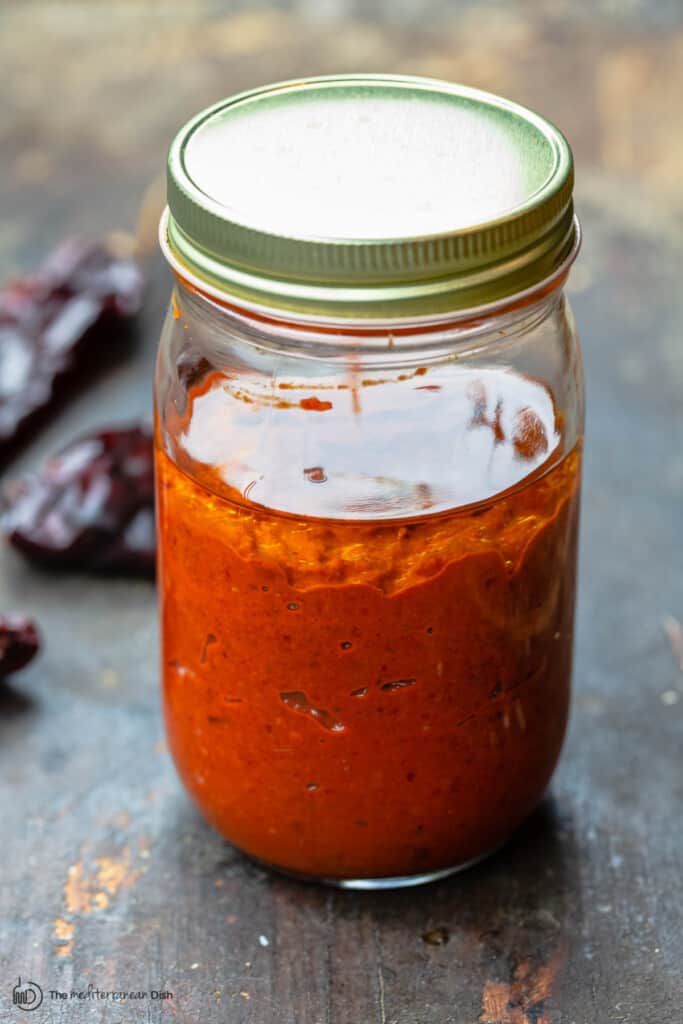
What kind of chiles to use for harissa?
Each batch of homemade harissa sauce may taste slightly different than the other, depending on the kind of chiles used. And as a result, some can be fairly hot, while others are mild.
You can pretty much make harissa out of any dried red chile according to your own personal heat index.
Because I like to control the heat factor in my harissa paste, I like the idea of using New Mexico chiles, which are milder but offer enough of a kick (Cookbook author Paula Wolfert believes that Gujaillo and New Mexico chiles are closest to the peppers of Nabeul and Gabès in Tunisia).
You can absolutely use a combination of chile peppers. Need more heat? Add a couple of de arbol peppers. If you like a bit of smokiness, add chipotle chile.
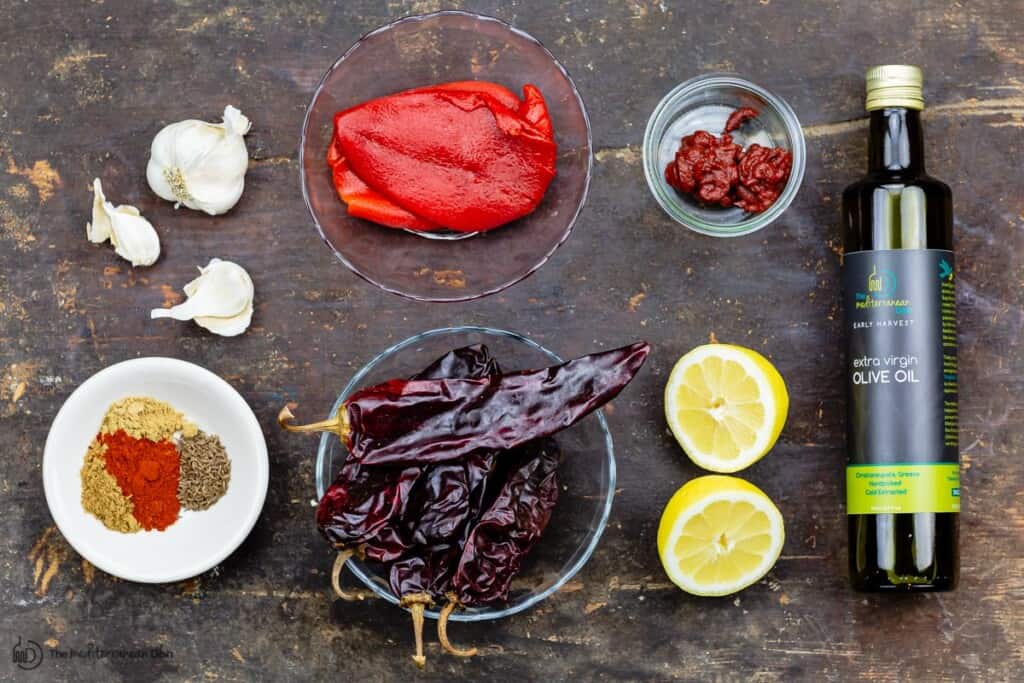
What you need to make it:
When I tested my harissa paste recipe, it was important for me to find the perfect balance of spicy, sweet, smoky, and tangy all in one red chile paste, and the following ingredients did just that:
- Dry red chiles (7 whole chiles). I prefer New Mexico chiles or Guajillo chiles which are milder (this allows me to add more heat as needed).
- Roasted red peppers (6 ounces or 2 large roasted red peppers). Jarred peppers will work here, just drain them well. These will add sweetness and also support the texture of the harissa paste.
- Tomato paste (2 tablespoons or so) for the umami factor.
- Fresh garlic cloves. I usually use 4 cloves, but if you enjoy more garlic, go for it!
- Spices. A combination of North African flavors from 2 teaspoons each coriander and cumin; 1 teaspoon caraway seeds toasted and ground (use a mortar and pestle, grinder, or food processor); 1 teaspoon smoked paprika (this adds depth and smokiness without adding more spice). I also use a pinch of cayenne pepper; start with 1/2 teaspoon and go from there.
- Kosher salt
- Citrus. Juice of 1 large lemon (do not skip this as it adds brightness and rounds out flavor).
- Extra virgin olive oil. This is drizzled into the food processor as the rest of the ingredients are mixing together. Use a quality EVOO that you enjoy; I used Early Harvest Greek EVOO.
How to make harissa
Making harissa at home could not be simpler!
First, you’ll soak the dry red chiles (whatever combination of chile peppers you selected) in hot water to rehydrate. If you don’t rehydrate them, you can’t exactly turn them into paste.
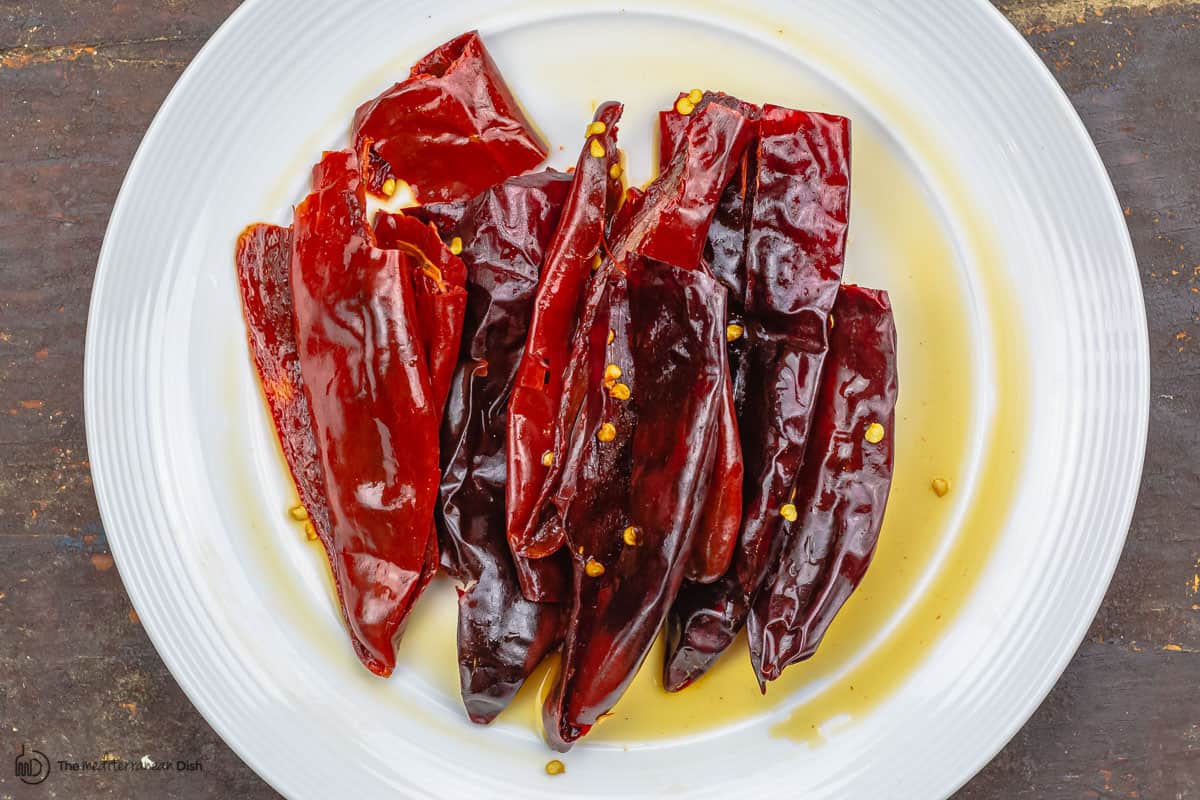
From there, seed the chiles and blend them in a food processor with the roasted red peppers, garlic, tomato paste, spices, and lemon juice.
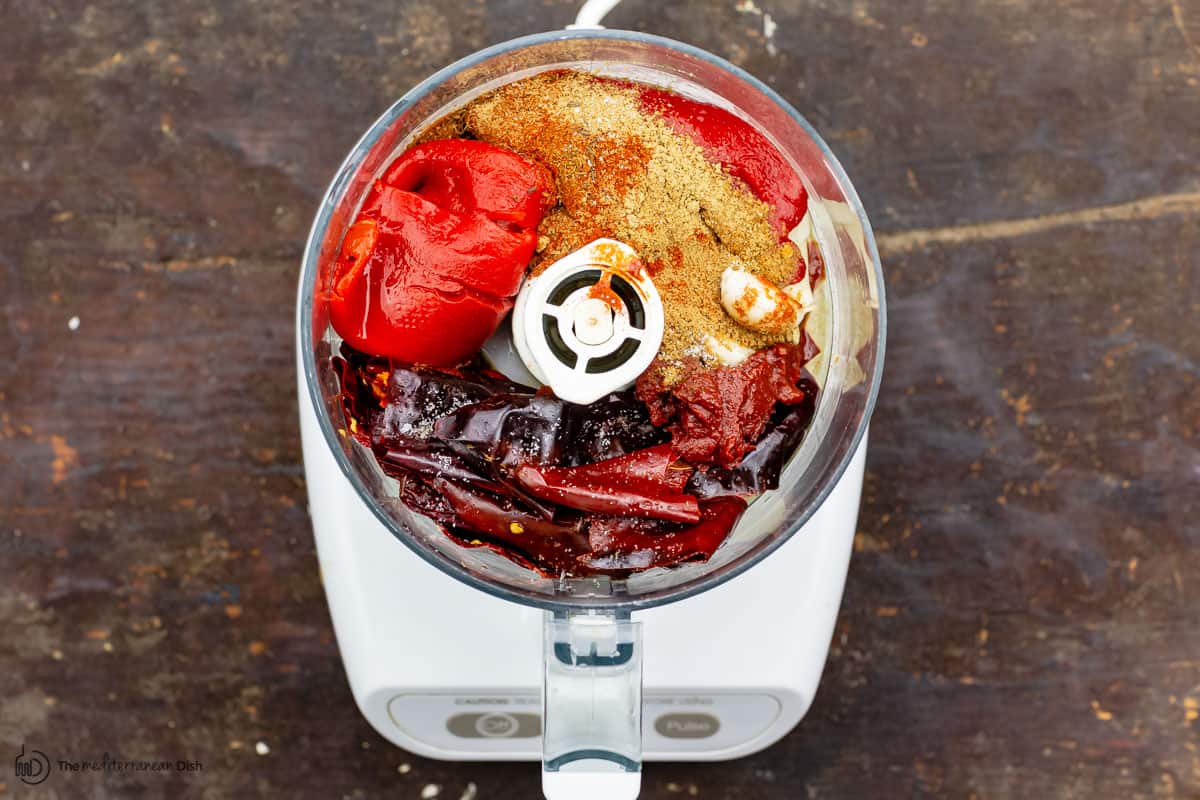
Drizzle the extra virgin olive oil as the ingredients are mixing until you arrive at a beautiful, slightly chunky paste. That’s it!
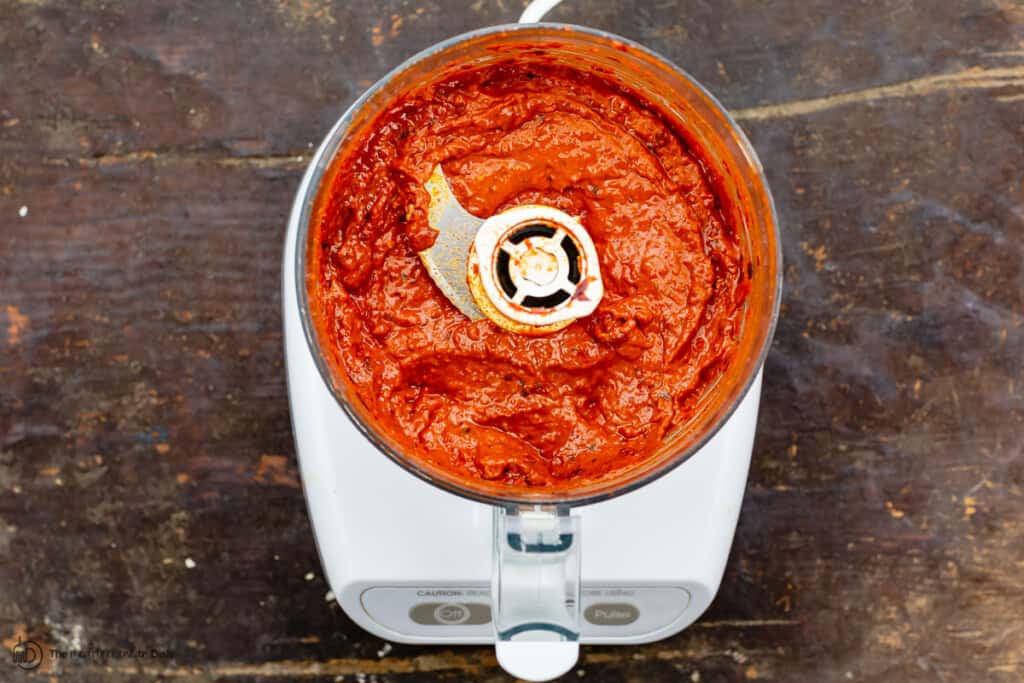
It’s even better the next day!
You can use harissa sauce as soon as you make it, but if you refrigerate it and use it the next day or two, the flavors will meld well and create a much deeper chile paste you’ll love!
Storage
I like to store my homemade harissa in the fridge in a tight lid mason jar. Adding a drizzle of extra virgin olive oil on top will help seal it well. It typically lasts 2 to 3 weeks in the fridge.
You can also freeze it for later use (about a month or so).
Ways to use harissa
Once you make harissa paste at home, you’ll find yourself using it in many different ways. Here are a few ideas:
- One of my favorite ways to use it is in this harissa chicken recipe. But it’s also great to season fish, fish kofta, or vegetables for grilling or baking. I also love the heat it brings to my Chicken Kofta Kebabs with Garlic-Mint Yogurt.
- Add a couple tablespoons of your homemade harissa to a soup like this red lentil soup or Moroccan vegetable stew or lamb stew. Or add some to your shakshuka for a little kick!
- Stir it in your hummus to add a kick or as a topping to your chicken kofta or lamb burger in place of Tzatziki.
- Use on scrambled eggs just like hot sauce, or whisk it into your Tunisian-style frittata.
Browse all recipes here. Join my free e-mail list
Easy Harissa Recipe
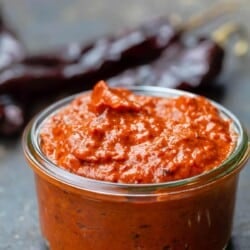
Equipment
Ingredients
- 7 Dried New Mexico Chiles or Guajillo Chiles, or a combination of dried New Mexico Chiles and another kind of dried hot chiles such as de arbol or chipotle chiles
- 6 oz jarred roasted red peppers, drained rinsed, and dried (2 large peppers)
- 2 tbsp tomato paste
- 4 large garlic cloves, peeled
- 1 tsp caraway seeds, toasted and ground (use a mortar and pestle, grinder or food processor)
- 2 tsp ground coriander
- 2 tsp ground cumin
- 1 tsp smoked paprika
- ½ tsp cayenne pepper
- Kosher salt
- Juice of 1 large lemon, 2 tbsp fresh lemon juice
- 2 tbsp quality extra virgin olive oil, more for later
Instructions
- Soak and prepare the dried chiles. Place the dried chiles in a heat-safe bowl and cover with hot water. Set aside for 30 minutes until the chiles are tender and re-hydrated. Drain the chiles and remove the stems and seeds.
- Combine chiles with the remaining ingredients. Transfer the chiles to the bowl of a large food processor fitted with a blade. Add the tomato paste, roasted red peppers, garlic, ground caraway seeds, coriander, cumin, smoked paprika, cayenne (if using), and a large pinch of kosher salt. Add fresh lemon juice.
- Make the harissa paste. Run the food processor, and while it’s running, drizzle the extra virgin olive oil from the top opening. Stop the processor to scrape down the sides and run again until you reach the desired paste-like texture. Taste and adjust seasonings to your liking (remember that harissa paste will deepen in flavor as it sits in the fridge over the next day or two).
- Store. Transfer the harissa paste to a clean mason jar. Cover with a very thin layer of extra virgin olive oil, then cover the jar with its lid tightly and refrigerate.
Video
Notes
- This recipe makes about 1 1/2 cups of harissa paste. A serving size is 2 tablespoons.
- Cook’s Tip: You can use this homemade harissa paste as soon as you make it, but for best flavor allow it at least 1 to 2 days in the fridge.
- Storage: Homemade harissa can last in the fridge for 2 to 3 weeks, properly stored in a covered mason jar and the top the harissa paste covered with a thin layer of extra virgin olive oil. You can use a little bit of the harissa paste at a time, but be sure to add a bit more extra virgin olive oil to cover the top before storing in the fridge again.
- Can you freeze it? Yes! You can freeze harissa paste for up to 1 month or so. Best to freeze individual smaller portions.
- Visit Our Shop to browse quality Mediterranean ingredients, including spices and extra virgin olive oil used in this recipe.
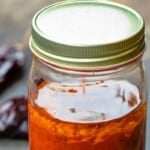
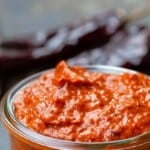
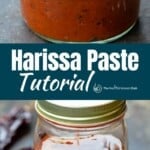
Tunisian Harissa is the best yumii!!
I just made this last night and I could eat the whole batch by itself! It’s going into a recipe, but I want to spread this on everything right now. Easy to make and completely delicious.
This was really delicious. I used New Mexico chiles and despite letting them sit for a few hours in warm water the skin was still a bit..not tender? Would also probably add chipotle to this as is suggested to get more of a smoky flavor. My background is Punjabi so I would definitely add more spice but my Iranian bf’s flavor palette can’t take as much heat haha so this recipe is perfect. Definitely recommend letting it sit for a day or two before having as mentioned. This recipe is a KEEPER!
I had the same issue! They’re really tough bits in the rehydrated peppers (I used guajillo) that I could not blend out. I tried twice, boiling the chilies the second time. Any advice??
Hi, Brandy. I would suggest pushing your harissa through a strainer to remove any of those harder bits that didn’t puree.
Spicy but tasty!
If I wanted to use whole coriander and cumin seeds what would be the equivalent to the ground? I find it easier to toast and grind those along with the caraway seeds for the recipe.
Hi, Sandrea. I just did a quick internet search and see that you would use 1 tsp. whole coriander for every 3/4 tsp. ground and 3 tsp. of whole cumin seeds for every 1 tsp. of ground cumin. Hope that helps!
Nice Harissa Chicken Recipe
Turned out great! I used some leftover Jalapeños from the garden! So yummy! Can’t wait to make other dips and sauces here in the coming weeks! Great recipe! Thank you!
Awesome harissa recipe!
Thanks, Frank!
Hi Suzy,
Can you make Harissa paste from the Harissa spice that you sell? I bought some and not sure how to use it.
Bob B
Hi, Bob! To make the paste, you do need to use the actual chiles here. A few great recipes featuring just the harissa spice, though, include our Vegetable Tagine, Roasted Cauliflower, and Crunchy Roasted Chickpeas. You can find even more my typing “harissa” in the search bar on the website. Hope that helps!
made the harrissa today. great flavor but theres pieces of pepper skin throughout it. is there a way to fix it? likely needed more tim rehydrating.
Hard to say, Jim, as we’ve not experienced that before. I think more time rehydrating might be helpful, though.
strained the harissa through a coliander. worked great. left skins behind. a day in fridge and the flavor was fantastic. i used it this morning in making Shakshuka for breakfast. really great dish. forst time every making it.
I have this problem every time I make harissa, any recipe. I’ll try your straining idea you posted below. Thanks for the idea.
One question. In Mexican recipes using dried chilis to make chili sauce, after running the chilis through a blender, one strains the blended chili mix through a sieve to strain out the tough skins. Wouldn’t that be necessary with this recipe to make a smoother harissa?
Hi, Ernie. We haven’t found it necessary to that with this recipe.
Love your recipes. I will be making this soon.
Just wanted to comment on all the people wanting to change your recipe. I don’t understand, just purchase recommended ingredients and have fun.
HI SUZY, THE RECIPE ABOVE IS BY USING 7 CHILIES. I WOULD PREFER MAKING MUCH MORE. IN FACT DOUBLE THE AMOUNT. HOW WOULD I MAKE THIS LOVELY TASTY HARISSA 🙂 🙂
SALAM EIDEK
Looks delicious! I’m wondering could I use Aleppo Pepper for the chilies and if so, how much would you recommend (e.g. teaspoon)?
Hi, Laura. I recommend sticking with the chilies here.
This recipe is excellent because it explains how items are used, and thus teaches cooking techniques, rather than merely stately what to do. (For example, tomato paste would add umami in soup as well.) So thank you.
After using dried harissa on chicken & really enjoying the taste, I googled the ingredients. Home-made has to be considerably better so I’ll be doing that from now on.
Thanks, Walter!
This is a great recipe. I didn’t have all the ingredients (dried chilies, corriander, or lemon) but I wanted to make it anyway. The only substitution was lime that was available. I love it! I am tryng to move to more vegan recipies and need more sauces to spice up simple recipes and this will do it. I am making chickpea pancakes with a hearty salad; this will complement the dish well. Other dishes I will experiement using this is roasted veggie pizza and adding this to mayo. This one recipe wiill go a long way.
Thanks so much, Selma!